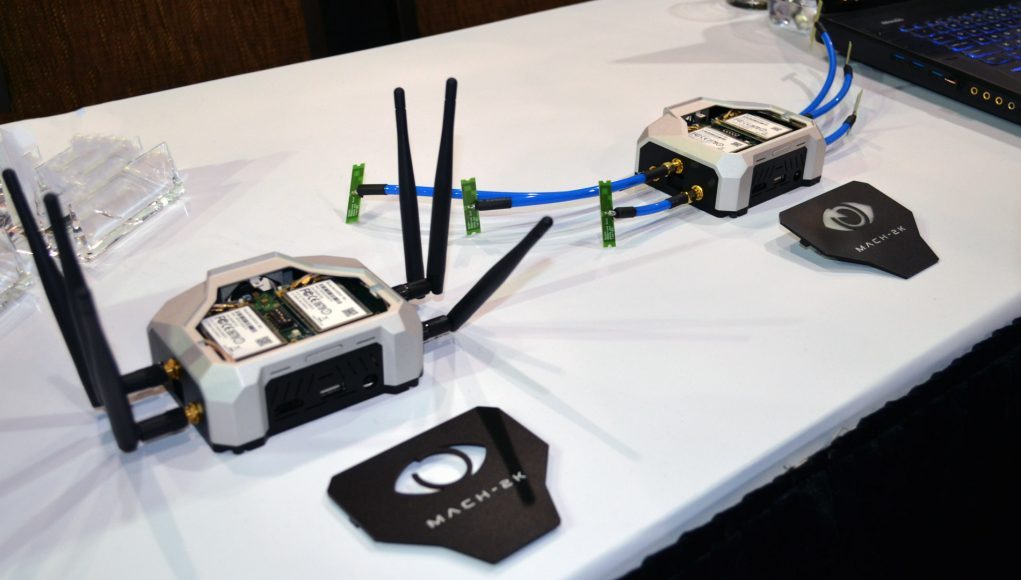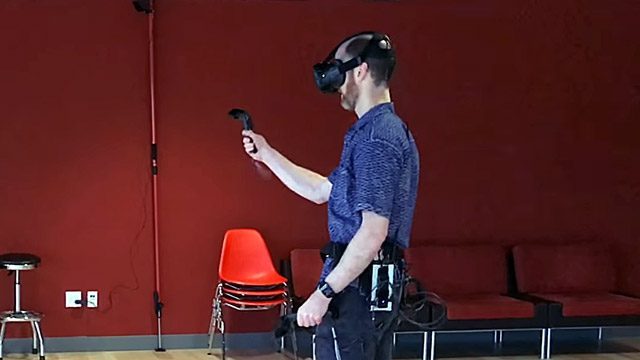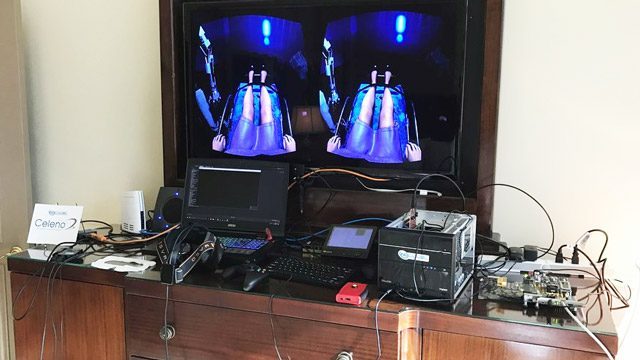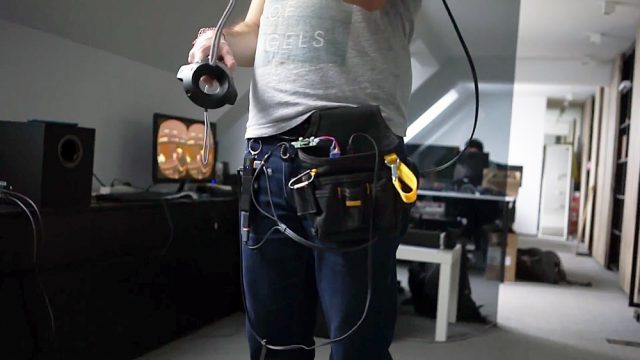Today’s most immersive virtual reality systems, like the Oculus Rift and HTC Vive, rely on a bothersome tether to send power and high fidelity imagery to the headset at low latency. But everyone agrees a dangling cable is not only annoying, it’s an immersion detractor. The demand for a solution to this issue has spurred the creation of no less than seven solutions (and counting) hoping to make a wireless link between the high-end host PC and the headset.
Update (1/2/18): A new entrant to the wireless VR space, Amimon, debuted their AMN 2130/2230 chips for wireless VR at the end of 2017. We’ve added their pitch to the list.
Update (4/28/17): When this article was originally published we hadn’t heard back from TPCAST. The company has since reached out to tell us more about their approach to wireless VR in their own words, and we’ve added that information to the list below.
First Published (3/24/17), Updated: Eliminating the tether on high-end VR headsets is an obvious desire with no obvious solutions. The issue comes down to three major factors: bandwidth, latency, and price; needs unmet by prior wireless video technology, which is why the big three high-end VR headsets that hit in 2016—Oculus Rift, HTC Vive, and PSVR—all rely on a cable which runs from the headset to the host machine.
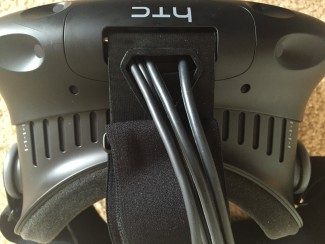 Unfortunately, the tether also keeps us connected to reality (the one we’re trying to escape with VR). Especially in room-scale VR—where you’re walking around, stepping on, or over it—the cable keeps us from completely detaching from the physical space we’re in; somewhere in the back of your head your brain is tracking the (virtually invisible) cable and deciding when you need to step over it, twist a different direction, or avoid hitting it with your arms. Ridding our headsets of the cable would mean deeper immersion and physical freedom within the virtual world.
Unfortunately, the tether also keeps us connected to reality (the one we’re trying to escape with VR). Especially in room-scale VR—where you’re walking around, stepping on, or over it—the cable keeps us from completely detaching from the physical space we’re in; somewhere in the back of your head your brain is tracking the (virtually invisible) cable and deciding when you need to step over it, twist a different direction, or avoid hitting it with your arms. Ridding our headsets of the cable would mean deeper immersion and physical freedom within the virtual world.
Now at least seven solutions are hoping to rise to that challenge, using a variety of technologies to make high-end VR wireless. This article is designed to give a broad overview of some of those proposed solutions & claims, and understand how each technology is being positioned. We reached out to several companies working in this space to tell us in their own words about their approach to making VR wireless and what they feel is their unique advantage.
– – — – –
Amimon
Netanel Goldberg, Sr. Director of Products
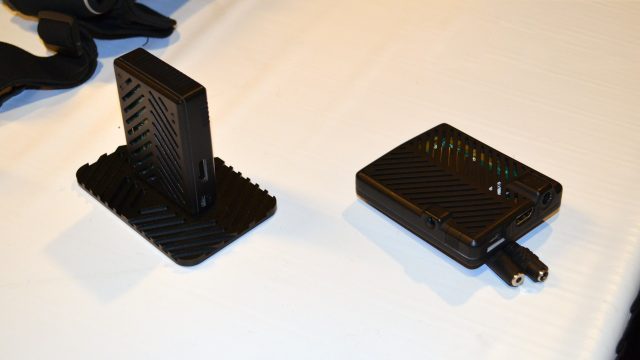
Amimon’s patented VR technology operates on the 5GHz band to deliver an unparalleled robust link, capable of supporting any environment, including large halls and advanced multi-user scenarios. Amimon’s advanced video modem on 5GHz supports crowded environments with multiple users using it simultaneously, and finally overcomes 60GHz band line-of-sight & blockiness limitations. The technology is compatible with most VR headsets, including Oculus, Vive and PSVR. The advanced video link system has an embedded chip that supports VR resolution of 2K at 90fps, similar to the Oculus and Vive, as well as 1080p at 120fps, like Sony’s PSVR.
IMR – Immersive Robotics
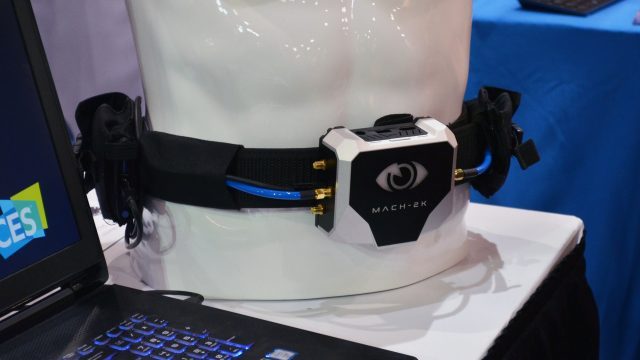
Daniel Fitzgerald, CEO
The difference between IMR’s wireless technology for HMDs and other companies is that IMR have been designing a VR standard designed specifically for VR devices that will allow VR video transmission between any VR device. More specifically, other solutions popping up on the market appear to use H.264 or similar chip solutions. The problem with this and what differentiates IMR is we don’t do frame to frame comparisons which immediately add at least 11ms latency (@ 90fps) and our solution doesn’t therefore introduce the frame-to-frame motion artefacts that you see with this older technology. The IMR VR compression standard was always designed for VR from the start so the result now is something special. We achieve 90-95% compression and the user is hard pressed if not impossible to tell the difference running through our system and the original.
IMR has developed an algorithm and hardware that enables wireless transmission and streaming of VR video over the leading wireless standards. The algorithm and hardware was developed to resolve more than one challenge i.e. wireless VR, but rather produce a standard which the entire VR industry can use; this extends far beyond what most people are thinking for just VR applications, including UAVs and robotics. The algorithms and overall technology IMR has developed for this VR standard can be used for transmitting VR data between any VR capable device—HMD, PC, Laptop, phone, camera, etc.
The new VR standard provides both the required video data compression and ultra-low latency for virtual reality and 3D remote presence applications now and into the future. The following is a description of its capabilities:
- Rapid Data Transmission: The 95% compression rate allows IMR’s technology to compress and decompress with a record breaking introduced latency of less than 1ms. This translates to zero perceived latency by the player, preserving user comfort due to the elimination of motion sickness that latency causes in VR play.
- Image Quality: The quality of the decompressed image is indiscernible from the original with no motion blur or introduced artefacts.
- Eye Tracking: IMR’s algorithm utilises single pass dynamic compression schemes, including foveation, tuneable parameters and offers support for eye tracking. Furthermore, the algorithm’s built-in flexibility facilitates further custom compression.
- Versatile: IMR’s technology can leverage both the 802.11ac and 802.11ad wireless standards as well as other wireless communications that have sufficient bandwidth. This enables current generation HMDs to be supported via the AC standard, and futureproofs the technology by enabling it to handle up to 2x 4K VR video transmission over the AD standard.
- Multi-faceted Application: IMR’s compression standard facilitates peer to peer data transmission between devices, to and from PC’s, HMD’s smartphones, 360 cameras and other VR enabled devices.
Our technology is designed to operate across all VR and telepresence robotics applications and each has their own requirements for the wireless. Our technology provides the necessary compression/decompression at ultra low latencies for ALL these applications, and we are working with and looking to partner with different wireless manufacturers and communication link suppliers to push this technology into each area.
KwikVR
KwikVR’s unique advantage over other wireless competitors is hard to tell, because we have not been able to test our competitors’ solutions. They are all claiming an impossible one or two millisecond latency overhead, so I would say our main advantage is to be honest. Also, our solution does not use 60GHz Wi-fi at the top of the head of the user, which might be better for health reasons. Using 5GHz Wi-fi is also less prone to obstruction issues when it comes to the Wi-fi signal. We believe that our latency overhead is close to optimal, but only the customers will be the judges.
NGCodec
I think you can classify Wireless VR into what type of radio it uses and what type of compression. Of course all systems have to deliver under a frame of round trip latency.
Various Radio Types:
- WiFi 802.11ac 5GHHz & 2.4GHz
- WiFi 802.11ad 60GHz
- 5G LTE cellular for cloud VR (various frequencies)
- Proprietary radio in unlicensed frequency (e.g. 5GHz)
Our solution uses WiFi 802.11ac and LTE. This has the benefits of not needing line of sight transmission. 60GHz transmission suffers from large attenuation when propagating through physical barriers including humans. 802.11ac can travel much longer distance than 60GHz and provide multiple room coverage. 802.11ac is also much cheaper and requires much smaller wireless antennas than 60Ghz. Placement of the transmitter is not important with 802.11ac unlike 60GHz. 802.11ac is also lower power giving longer battery life of the HMD.
Various Compression Types
- JPEG (Intra frame) with 3:1 compression
- JPEG 2000 (Intra frame) with 6:1 compression
- MPEG H.264 (Intra and Inter frame) 100:1 compression
- MPEG H.265 (Intra and Inter frame) 200:1 compression
- Proprietary Compression
Our solution uses MPEG H.265/HEVC compression which provides 200:1 compression. E.g. a source of 1080p60 requires 3,000 Mbps to transmit uncompressed. We compress this to 15 Mbps a compression ratio of 200:1. This allows headroom for error correction and higher resolutions and frame rates as well as data rates that can be delivered from the cloud over 5G LTE and fibre networks. Standards based systems also allow off the shelf mobile chipsets to be used to build into mobile HMDs. We will adopt future H.265 profiles which can provide even better compression using tools like multi view and screen content coding tools.
Nitero
While other vendors are focused on bringing wireless accessories to today’s HMDs, Nitero is the only company developing an integratable solution that will support the aggressive requirements of future VR HMDs.
The solution’s novel micro-second latency compression engine provides royalty-free, visually lossless encoding, adding end-to-end latency of one millisecond. At power below one Watt, it can be integrated into future headsets without the need for expensive heat sinks or vents. In fact, adding Nitero’s wireless solution will be significantly less expensive than cables, resulting in an overall cost reduction, which is critical for VR adoption going forward.
Interoperable with WiGig, Nitero has customized for the unique challenges in the VR/AR use cases with advanced beam-forming that supports NLOS at room-scale. Additionally, back-channel support for computer vision, eye-tracking, 3D-audio and other forthcoming technologies can be supported simultaneously with the VR display, without needing another chipset.
Some of the industry leaders that have supported Nitero via investment and collaboration include Valve Software, Super Ventures, and the Colopl VR Fund, along with others not publicly announced.
Update (1/2/18): Nitero was acquired by AMD as of April 10th, 2017.
QuarkVR
We use a combination of video compression and proprietary streaming protocol that allows us to stream high resolutions to multiple headsets. Our solution is designed primarily for Theme Parks and Arcades that want to put two or more people in the same tracked space.
Our thesis is that in the future you will always need some amount of compression, either when resolutions get higher (4K and above. We need 16K for retina resolution), or if you try to put the server outside the local network. Ideally, you could put a GPU farm in the cloud and have all the content available immediately thus even eliminating the need of a PC at home! I think that in five years the only computer you would need at home would be a small mobile chip, probably built into the headset itself.
Of course, any sort of compression introduces latency. However, there’s been a lot of development in the past two years to go around that. We’ll be releasing a network aware technology similar to Spacewarp that’s used by Oculus. And companies like Microsoft have done a lot of research on reducing latency by doing predictive (also known as speculative) rendering. Project Irides, for example, is able to compensate for 120 ms of network latency in their demo. We’ve been talking to one of the lead researchers of Irides for a while, and we’ll release similar technology in 2017. So I would say that the future of wireless VR is very bright!
TPCAST
David Jian, Co-founder & VP
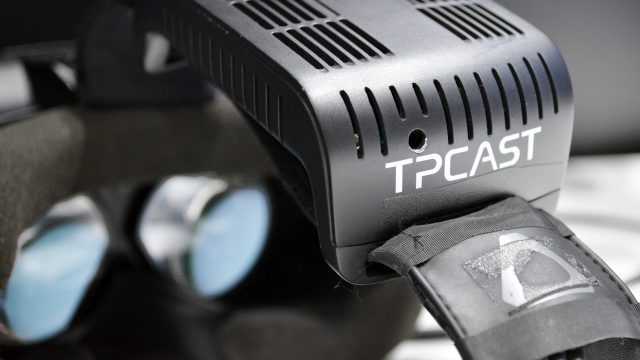
The advantage of TPCAST Wireless Adaptor is near-zero latency, and no compression of image. We believe these two characteristics are key standards of high-end wireless VR. Any noticeable image compression is not acceptable in VR, due to its high requirement of image resolution.
The biggest difference between TPCAST and other companies is that our device is not a prototype or model, but a product, which is the world’s first commercial tetherless VR product.
In the last four months, over 1,000 people have experienced TPCAST WIRELESS ADAPTOR for VIVE personally on VIVE X demo day (BEIJING), CES, MWC, GDC and GUANGZHOU VRAR SUMMIT. Almost all of them felt no difference from tethered Vive, especially the near-zero latency. These positive evaluations means a lot to us.
Here are the specs of TPCAST Wireless Adaptor for Vive:
- Video Format:HDMI2.0
- Video resolution:2K (2160*1200)
- Video Frame Rate:90Hz
- Latency: <2ms
- Transmission range >5m 360°
- Power Consumption:4W
– – — – –
These are not the only companies working on wireless solutions for desktop-class VR, but this survey we hope shows a breadth of approaches to the problem. Another notable solution is an Intel and Vive wireless VR initiative which the company has said is based on WiGig.
We’ve had a chance to test out a number of these technologies, but not yet in appropriately controlled conditions. Expect more coverage to come as these products get closer to market-ready.

